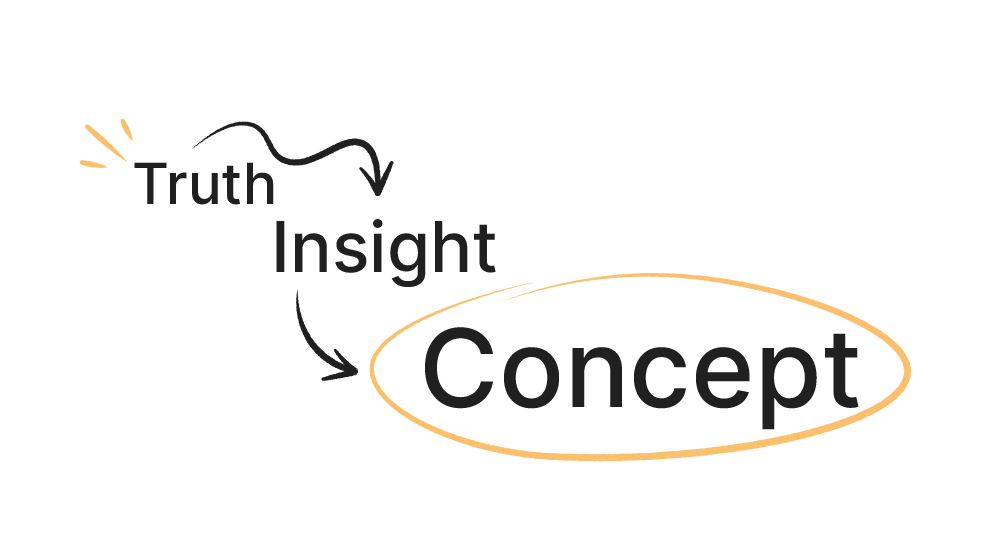Hiya, Associate Creative Director Chris here. You know, the guy from the video. At a different time in my life (and LinkedIn profile), I was a student at Chicago Portfolio School—where postgrads learn how to make ads. In the year I spent there, I learned two very important things: 1) the fine line between a school and a scam and 2) how and why some ads are awesome, and the rest get skipped. Or, even worse…forgotten. Today, I want to talk about the awesome ones and the creative concepting it takes to make them.
You see, the key to a really good ad (or any marketing message, really) is a really good concept. In school, I was taught how to develop concepts by following a proven formula. These days, I use that same formula, or at least, the principles behind it, in all my creative pursuits—advertising or otherwise. Unfortunately, since my “alma mater” has gone the way of the dodo, it is my duty to pass my concepting knowledge on to you, dear reader. And unlike me, you won’t have to pay tuition! Just pay attention and see what sticks.
The (Not So) Secret Formula
Sorry, but before we talk about that formula, I gotta explain what a concept is. There are many definitions and opinions in the ad world. No surprise there. I’ve heard concepts called “an idea with an insight behind it.” A more bookish definition might be “a high-level message or theme that creates an emotional connection with the audience.” Some folks simply think of it as “the guide for all creative decisions.” And I’ll be sure to tell you my personal definition a little later in the post.
For now, here’s that formula, exactly as it was taught to me:

A Human Truth: Every good creative concept begins with identifying some sort of fundamental, inarguable human truth. That could be a super surprising fact, a common behavior or an emotion we all relate to. By starting with a truth, every concept you come up with carries deeper meaning. Plus, every conversation with your audience starts from a shared perspective and understanding. All good stuff.
An Insight: The insight is the connection between your product or service and the truth you’ve identified. Think of it as a clever twist on the truth that gives viewers an “aha” moment. An insight should offer a new or novel perspective to consider. When the audience is asking “yeah, so what?,” the insight is your answer.
A Concept: The concept is the all-encompassing creative solution built from your best insight. It should be a quick, clear and clever way to communicate your truth and insight across every element of your ad. Great concepts effortlessly demonstrate how well you understand the audience’s problems and your ability to solve them. If you put in the work during the first two steps, your concepts are guaranteed to resonate on an emotional level with all the right people. AND, maybe most importantly, that idea can be used across multiple mediums to send the same message.
For a practical example, there’s the a pretty famous campaign from the 90s. The agency, Goodby, Silverstein & Partners, was tasked with getting people to buy more milk. During their initial research, they discovered that most folks don’t actually think about needing milk until they’re already out—an odd behavior and interesting truth. Then, they dug deeper. The team removed milk from their break room and observed the reactions. Milk’s sudden absence became a frustrating hitch in everyone's office routine. Turns out, we tend to take milk for granted. That unexpected twist became the insight. With truth and insight set, the concept began to crystalize—let’s remind people just how miserable it is to run out of milk. Thus, Got Milk? and the first deprivation marketing campaign were born. The concept and campaign continued far beyond those original ads to become a cultural icon. All because it began with an honest, clever concept folks could relate to.
There's A Reason You Need A Concept
Now, there’s a reason this formula works for advertising. People are motivated to action by emotional appeals much more than rational ones. Creative concepting puts relatable human truths and emotions at the core of your messaging. Viewers are able to understand more than what a product or service does. They see what it can do for them. It ensures every element of the message, no matter the medium, has a purpose—a reason to be what it is. And that’s the most important thing I’ve held onto since “graduating”.
If you ask me, concepts are the BETTER REASON WHY your video exists.
Creative concepting connects your message to an emotion, a feeling or a larger idea. Every one of those examples is a much better, more meaningful reason for a video to exist than the need to increase clicks. Finding that reason means honing on exactly what you’re actually trying to do. And, more importantly, why are you doing it?! The concept is how you go about communicating that.
Whatever concepts you come up with are bound to be a better reason to watch and listen. With every concept we develop, we want to weave together what the client needs to say with what we know the audience wants to see and hear. If we do our job well, those two things become one in the same. And with the variety of projects and clients we take on, that process never looks the same way twice.
The Way We Do Creative Concepting at DD
Let’s take Newsela, for example. Newsela came to us with half of an idea—turn their message into memes. It was our job to figure out the WHY behind that. We flipped the classic concept formula and started to reverse-engineer some ideas. We realized that memes are all about emotions. When someone sends you a meme, you feel seen. Once we had that line in our minds, we were off to the races. The reason we were making these videos was to make teachers feel seen with memes.
We stayed on that track, drawing inspiration from popular meme formats. The edit structure was like reading a tweet. Copy was industry-specific and drew from hashtags like #tfw. We emphasized emotions with real life doodles of situations using classroom clutter. Even though the execution was decided for us, success meant ensuring every creative decision had a solid reason why it was made.
On the other end of the spectrum, there’s Bionic. The target audience for the video was entry level media planners. During the brainstorm, we talked about the pressure we all felt in our first job. “It’s like you’re under a constant spotlight”. That particular idea really resonated. Spotlights create stress and pressure, but they also shine on the star of the show. And work is literally a performance that gets reviewed every few months.
Things quickly fell into place and the reason for the video became showing folks they can thrive under the spotlight with Bionic. And what better way to capture that than writing a short musical where a character full of theater kid energy—some of the most confident people around—shows their co-worker how to own that spotlight with the power of Bionic. We even carried the concept through to a series of screencasts that open with a curtain and use the spotlight to highlight important actions.
OK, So What?
Both these concepts managed to bring that essential extra layer of creativity, connection and meaning to the message—without following the exact concept formula. Not every video needs to reveal some profound truth or insight about human existence to succeed—especially when you’re telling instead of selling. Your concept doesn’t need to be an amazingly clever, transcendent idea that takes weeks to come up with. It just needs to be honest, and it needs to work.
As proven by these examples, and so many of the videos we make, concepts are all about getting you, and the viewer, to think and feel more. Every choice made should have a solid creative reasoning behind it. Arbitrary choices kill creativity faster than anything. So make choices that are novel, unique and unexpected! Developing a concept, asking the right questions and really considering your creative executions is how audiences come to connect with your content and better understand your brand. It also shows you care about how they think and feel for the few minutes, or seconds, they spend with you.
Creative concepting can take the tedium of explaining security software and turn it into a super team defending the cyberpunk metropolis of Net Work City. They can help to bring out the essence of a brand, expanding into fully-realized, full-motion ideas. And, they help ensure creative that truly suits the client, even when we start entirely from scratch. Concepts can also be a huge part of telling stories in unscripted videos, too. Like the classic tale of small parts coming together for a greater whole—whether it’s teams of people OR robots.
If you're reading this, you’ve officially completed Chris’ Crash Course in Creative Concepting (TMTBD). I hope you’re ready to take on the challenge of crafting some great concepts on your own. For those of you who'd rather see what Demo Duck’s ultra-flexible concepting process looks like in action, don’t hesitate to reach out. I know you have plenty of interesting truths and insights rattling around in your head already, so let’s see what concepts and content we can squeeze out of them!
